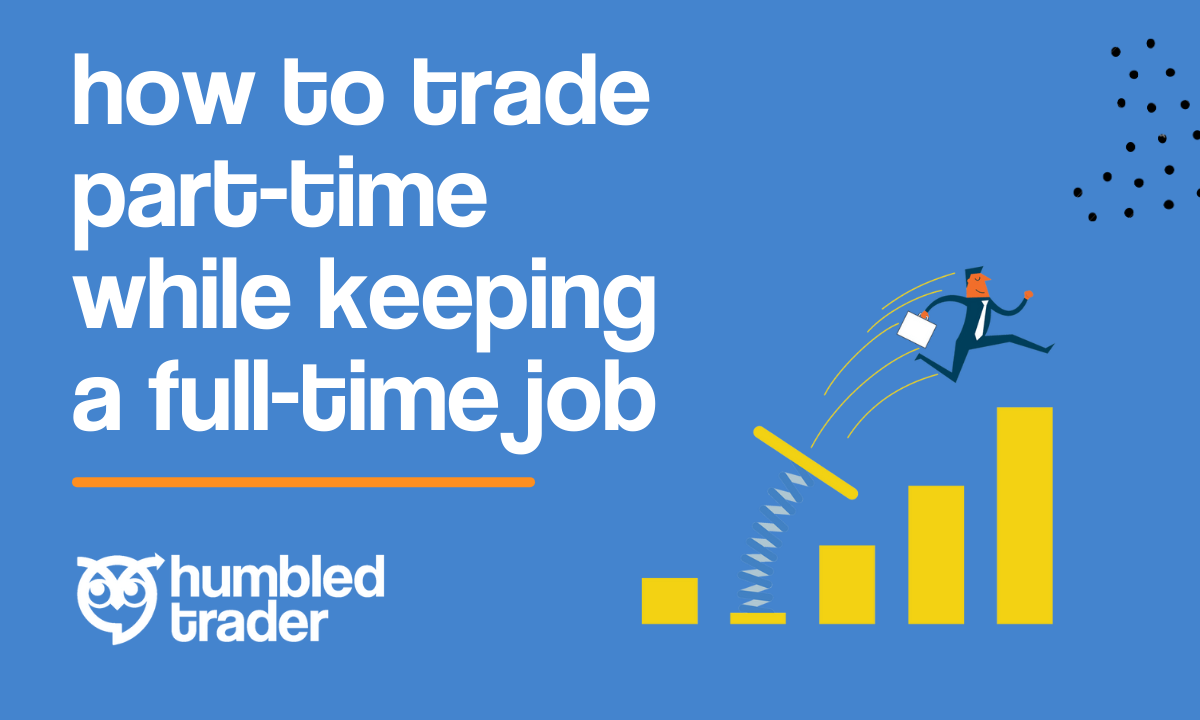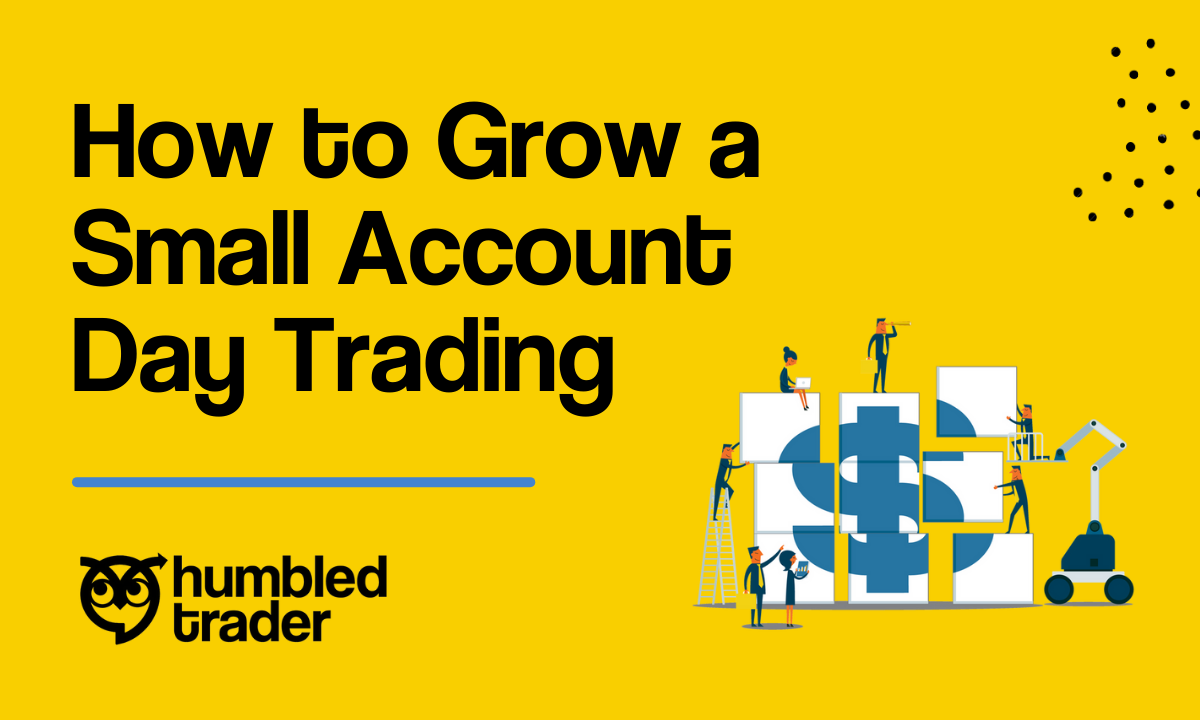How I Was Part-Time Trading With A Full-Time Job

Are you struggling to trade part-time while working a full-time job? Then this blog post is made for you.
I’ll be talking about my personal part-time trading routine that has allowed me to eventually quit my 9-to-7 job and become a full-time day trader. Sharing some amazing tools and strategies for part-time trading, best practices and rules for part-time traders of all timezones, and a list of deadly mistakes you definitely must avoid if you are trading part-time.
My name is Shay, aka Humbled Trader. Over 8 years ago, I had a real job. I was learning to trade part-time while working my dreadful 9-to-7 job in the VFX and film industries.
However, through a lot of struggles and breakthroughs… I slowly grew my trading account on the side. I’ll be sharing that with you today.
Whether you plan on quitting your job to become a full-time trader or you want to stay a part-time trader doing this as a side hustle and as another source of income, you will definitely learn a lot in this blog post.
My Part-Time Trading Daily Routine
Let me first share with you my exact part-time trading routine from years ago, when I had a 9-to-7 job. And yes, I did say 9–7. If you have a 9-5 instead, you are so lucky.
But remember, whether I worked hard or slacked off and watched Netflix all day, stayed busy or not in the office during my 9-to-7 job, I was still guaranteed a paycheck at the end of the day. I never had the risk of losing money, just the risk of losing my soul.
As you know, I am a trader living on the west coast. When I first started as a beginner day trader, I was living in Los Angeles and then later moved to Vancouver, Canada.
Since I live in the west coast time zone, that means we are 3 hours ahead of the market opening. (Don’t worry, I'll give you tips for other timezones later on as well.)
Morning Routine: picking the stocks
My typical morning would look like this: wake up at 5 a.m. PST in the morning, which is 8 a.m. market time.
By 5:15 a.m., I would be at my trading desk and starting the premarket research process. I’ll start out by scanning for stocks to trade with my premarket scanner. I'm looking for stocks to gap up or down hugely overnight.
And obviously, the trade planning doesn’t stop there. I will proceed to read the news catalyst on these overnight gappers. Are they gapping up because of a new $500 million contract from the government or earnings beats? Or are the stocks gapping down because of the overall market's fearful conditions, or have they missed big on earnings?
Planning the strategy
After I've selected a handful of stocks, I'll actually spend time charting out the levels and planning out the strategies I would use to trade them. So basically, I'm spending the entire 5:15 am to 6:00 am local time to plan out the trades I’d execute at the market open.
I know some of you might be wondering, but Shay, what about premarket trading? The answer is that I rarely trade premarket. The reason is that for the strategies I traded, I needed a lot of range and volume.
I know 2020 and 2021 really spoiled many traders. Those two years were indeed amazing times to trade during the pre-market session. I definitely participated in trading premarketing during those times as well.
However, generally speaking, I found that most of the time I didn't execute well premarket because of a lack of liquidity during that time. And also, keep in mind that you cannot place stop-loss market orders during extended hours; you can only place limit orders.
So to avoid execution errors, slippage, and bigger-than-expected losses, I prefer to take that time to refine my trading plans for the open.
At that time, so many years ago, I strictly focused on long strategies; I didn't quite know how to short yet.
Whether you are a long- or short-biased trader, the opening 30 minutes to an hour is where you get to execute some quick trades, be done for the day, and head out to work. Note that I said quick, but not easy.
From 6 a.m. to 6 a.m. I will take a quick coffee break, do some stretches, and get ready for the market to open.
Market open: Trading the Plan
Once the bell rings at 6:30 a.m. my local time or 9:30 a.m. market time, I will trade and take advantage of volume momentum within the first 30 minutes to an hour.
In the earlier planning sessions, I would have around 4 stocks on watch when I was trading part-time.
Most times, I really only execute two trades. And in case you are wondering, no, I didn't have all of this screen real estate when I was trading part-time. My setup years ago was really simple and cheap.
I had a laptop with one external monitor connected. I started out using a Macbook running Interactive Brokers, TWS, and Thinkorswim. However, I eventually upgraded to a PC to be able to run more advanced broker platforms with faster executions.
When you are trading part-time, I recommend keeping your setup simple. Just have enough screen space to focus on one stock at a time.
(And no… I do not recommend trading on your phone. I actually have a story on this later on…)
My trading in the morning would end at around 8 to 8:30 am local time, which is around 11 to 11: 30 am market time.
Working Time: Do not trade during work
That's when I’ll hurry up, close my positions, pack up my things, and go to work. And u know… most of the time I end up showing up 30 min late for work art around 9:30 or 9:40…
But hey! As long as no one finds out you are sneaking in from the back door at work, it's fine. I hope none of my previous bosses or managers see this. Actually who cares that was years ago.)
I'm not suggesting you go to work late, btw. I'm just suggesting that perhaps you could really maximize your time productively while increasing your earning potential.
Even though I used to show up to work late a lot, my managers knew I was very efficient and could still meet all of my deadlines. So my work never actually suffered.
All jokes aside, please remember to do your job, and keep your job, please! You need a stable income from your job in order to trade well, especially if you are still learning as a new trader.
And during the day while at work, yes, I would check on the overall market once in a while on the phone. But generally speaking, I do not trade while at work. And even if I do, it's just closing the rest of the position that I had already entered in the morning.
I would only leave positions open while at work if I was trading mid-cap and large-cap stocks. I never liked to hold onto small-cap, low-float penny stock positions for an extended period of time.
These low-float stocks are way too volatile and unpredictable. Their volume can drop significantly at midday and slowly bleed out in prices for the rest of the day.
Or, once in a blue moon, they can trap below VWAP and rip into the afternoon, squeezing out all the shorts.
Generally speaking, I believe having all the day trades closed out before going to your full-time job is the way to go. Whenever I did that I felt way more at ease and I could fully concentrate on my job without distractions.
Imagine if a stock drops due to a negative news release in the middle of an important call at work, or imagine if you walk into a meeting thinking that, oh, you’re up a grand on your long position, and after the meeting ends 1 hour later, you see a red negative $3000 because our best friend J. Pow Pow (the Fed’s chair) said something hawkish after reviewing some economic data.
Yes, that actually happened to me years ago during a meeting. And I had to sit through the rest of the five hours at work. Every second was torture knowing that I’d make $200 by the end of the day… and that’s not even enough to cover 30% of my big mistake from trading today.
So guys and girls, please learn from my lesson. Whether you are a part-time or full-time trader, neither of them means trading all the time.
After that incident, I personally didn’t want to take that kind of risk if I cannot’t fully concentrate on the ticker.
Whether you want to manage your positions full-size on your desktop or on your phone while at work or have a stop-loss order in place, that’s entirely your own decision, of course. I'm just sharing my tragic story here to provide a reality check.
Stock Market Close: Swing trade time
During power hour, from 3 p.m. market time to close, which is 12 p.m. lunchtime for me, I don’t actively day trade.
Most of the time, I spend the hour looking for stocks that are closing strong on the day and holding daily key levels on my phone or on my computer.
And if I see some stocks that have a good chart (bullish chart) and good strength (closing with strength) into the close, then I would look to take a swing position overnight or in the next few days.
Again, we’ll talk about the actual strategies later on. This would be great for part-time traders who are still under the PDT rule (Pattern Day Trade Rule) as well.
But the work doesn't stop there when the market closes at 4 p.m. Eastern. If you haven’t noticed by now, trading part-time while working a full-time job actually requires full-time effort.
After work: Research Time
At the end of the day, after getting home around 8:00 p.m., I would still spend about 2 hours before going to bed researching and analyzing the top movers of the day. See how each gapper I had on watch this morning performed.
Some additional homework I would do in the evenings is:
planning out my levels on my charts,
journaling trades from the morning into my journal and watching any video lessons from the trading communities I was a part of.
This way, I can speed up my premarket trade planning process the next day. Remember, trading is 90% about the work you do outside of market hours.
Key strategies and tools
So that was an extensive breakdown of my part-time trading routine, from when I had a full-time job. Now let's move on to talking about some of the key strategies and tools that you can use to optimize your part-time trading.
Long strategy for part-time trading
As mentioned earlier in the video, when I was a part-time trader I mostly only focused on long strategies. I would buy the dip on strong stocks with positive catalysts. Most of the time and sometimes I would join the trend long instead of buying the dip.
When you buy the stock with the anticipation that it will increase in price, and once it does, you sell to realize a profit. A long strategy is when you only invest in long positions.
A very important part of this strategy is to be able to pick up stocks with strength and high volume that are potentially great for your long strategies.
So that's why I set my scanners to scan for stocks with the highest % gap and the most volume. Both of these are the most important technical criteria you can scan for.
In my first year or so of trading as a beginner, I didn’t have the money to purchase scanners. So here are my recommendations for free market scanners you can use to find suitable gappers for these long strategies: Webull, Thinkorswim & Finviz.
They are not perfect, but they would be able to find most gappers every day.
But after about 2 years I transitioned to paying for premium scanners, and that was a game changer. I can do so much more than just scan for stocks, now I can find all the average volume, float, market cap, short %, and average daily volume within a few seconds.
This saved me so much time. And especially when every second counts as a part-time trader, paying for premium scanners allowed me to build my morning watchlist faster and more efficiently.
I have been using and paying for a trade idea scanner for so many years. I highly recommend it. You can download my scanner settings down below and try them out. If you are trading part-time and need to speed things up every day before going to work, this is worth it.
A second strategy I would highly recommend for part-time traders to build their accounts is swing trading.
Swing trading Strategy for part-time trading
The next strategy that worked really well for me when trading part-time was swing trading.
There were periods of time when I was so busy working overtime for certain film productions that I just couldn't wake up in the morning at 5 a.m. after staying at work late till 9 or 10 p.m.
So that's where I developed this backup strategy for swing trading. There were two kinds of swings I’d trade.
Overnight swing strategy
One is an overnight swing strategy. I would use my lunchtime break around 3–4 p.m. Eastern time to find the top gainers of the day. Again, you can do that easily with the free or paid scanner I mentioned earlier.
Then I would study the catalyst on the gainer. Rule out the top gainers with no news or fluff news. And only narrow down to one stock that's closing strong on the day with really bullish news that is likely to have continued for the next day or the next few days. And I will buy the stock overnight.
Weekly swing strategy
However, in recent years, I have found that I swing overnight less and less, and I prefer to open swing trades that would take a week or more to play out. I’d pick stocks that are consolidating on the daily chart and are part of a hyped sector with a lot of chatter.
An example is my recent AI stock swing trade that I mentioned in the ChatGPT video. I bought the stock around 20–21 and swung it to 26 dollars for a nice 24% profit in a week.
This swing strategy would be an especially valuable solution for the part-time traders in the US who are under the Pattern Day Trader rule and trying to grow their small account while working their 9-to-5 job.
Remember, if you buy a stock with the intention to swing it overnight and sell pre-market the next day or 3–4 days later, that would not count as a day trade for you.
OCO orders (One Cancels the Other order)
To execute both the day trading and swing trading strategies mentioned earlier, I’d highly recommend you try out OCO orders on your execution platform.
OCO orders stand for one cancels the other order, also known as bracket orders. Essentially, this allows you to manage your existing position when you are on the way to work or at work. If you really must trade at work, You get to set live take-profit and stop-loss orders.
But remember, you've got to protect your downside. The second half of your OCO is a stop-loss market order. Let's say you only want to risk 50 cents from $195. So you set a stop-loss market order at 194.50.
This OCO would be perfect because if either one of the take-profit or stop-loss orders is triggered, the other linked order will be canceled. Hence the name “one cancels the other.
That's why OCO orders are also known as bracket orders. Because you have an order limiting your downside below, while another one helps you take profit above.
Remember to use market orders to stop losses. Whether you are long-biased or short-biased, you are basically never safe leaving these day trades on without proper stops.
Part-Time Trading Pro Tips
Besides the tools and strategies mentioned earlier, here are some very important tips from me to you. If you are a part-time trader at the moment and looking to trade well, generate some consistent profit while working a full-time job. You will want to learn from my costly mistakes.
Know when to walk away
The first one is important, and I know you won’t like hearing this.
In trading, it's not necessarily hard to make money, but it's extremely difficult to keep it. When I was trading part-time, I found it very hard to shut down my computer and pull myself out of the market.
If I had a good day and the market was hot, I would want to keep pushing and really try to make more money. And if I had a bad day, then I would want to stick around longer to make up for my losses.
Both of these situations would lead me to overtrade and give back all of my morning gains, or even worse, make me lose even more money than before. As part-time traders with full-time jobs, you shouldn't need to push that all day, every day.
Remember to take it easy and slow. Put in the hard work, yes, but the market is still going to be open tomorrow. Take the meat of the move and run. This is true for day trading and swing trading.
There were many months where I just couldn't find good potential swing trades to hold overnight or for a few days. I used to force those trades and lose money… Those were really stupid mistakes on my part, so I hope you don't do the same.
Do not quit your job.
I know you also won't like hearing this, but I'm just being realistic here. Do yourself a huge favor and keep your job.
Contrary to what the lifestyle marketing around this whole day trading industry tells you, quitting your job altogether to day trade. Is really not as glamorous or easy as it seems.
While yes, I hated my 9-to-5 job just like most people, keeping that job meant I had a predictable employment income and some financial stability. These were key factors in allowing me to trade well after quitting the chat room alerts and slowly building up my small trading account.
Because let’s be real here, you can spend 8 hours a day trading in front of the computer, but you are not guaranteed a paycheck; you can even lose money. But that 9-to-5 job you go to every day is guaranteed income.
Having a stable income that you can count on will give you the mental comfort to take trading slowly and allow yourself more time to learn about yourself as a trader. And yes, your employment income will pay for your market tuition.
It’s unfortunate, but losing money is part of the business of trading in the beginning. It's evitable. The key is to control your losses and keep them small.
And the only way you can cut your losses small is if you are not attached to the money because you have your full-time job or jobs to pay your rent, your food, and provide for your kids or family.
I'm sure some of you are thinking… Okay, Shay, your part-time trading routine works well for you because you are on the west coast PST time. But what if I'm closer to the Eastern time zone?
While I’ve never lived and traded there for an extended period, I do have some tips after gathering them from traders in my community.
Actively seek to work from home.
After 2020–21, most workplaces will allow you to work from home at least two days a week. So organize your work schedule and trading schedule and block out time for each.
Negotiate a different starting time.
Instead of starting to work at 9 a.m., see if you can negotiate to start at 11 or 12, and just stay later to 7 or 8 p.m.
Yes, that means no more partying in the evenings or dining out.
As I mentioned earlier in the video, it all comes down to sacrifices. Do you want this bad enough? Maybe it means going a little less on weekends. Eating out only once or twice a week and sleeping only six hours a day.
But of course, if everything I just talked about sounds like too much effort and too much time, there's still hope. My answer to that is chat room alerts ” baby. It takes only two minutes to make millions. works perfectly, 1% of the time.
If you are a part-time trader looking for even more tips on optimizing your strategies and increasing your profits, then you should check out my conversation with Ryan PDT, a part-time trader with a full-time job. On the brand new Humbled Traders podcast. Check it out over there.
Don’t feel like reading? Watch the video.



